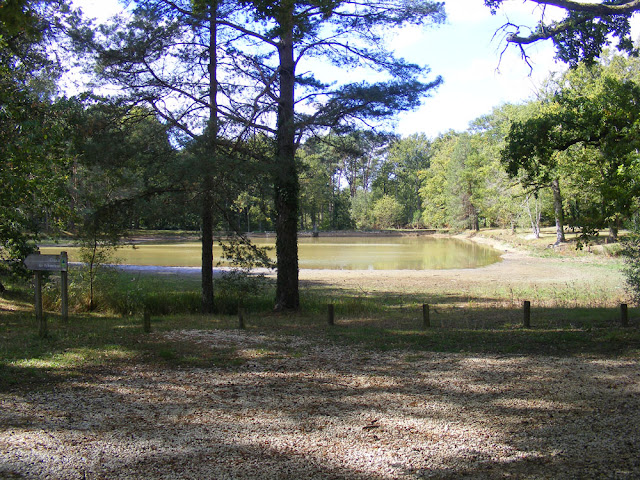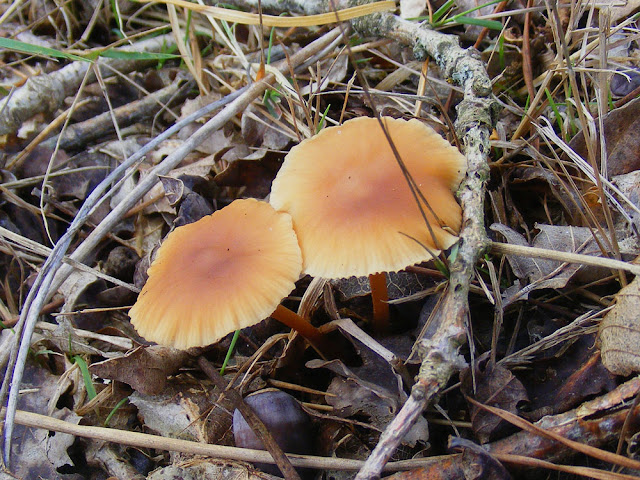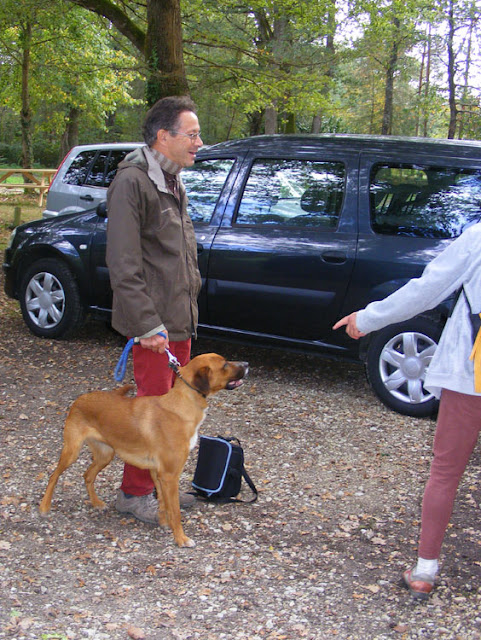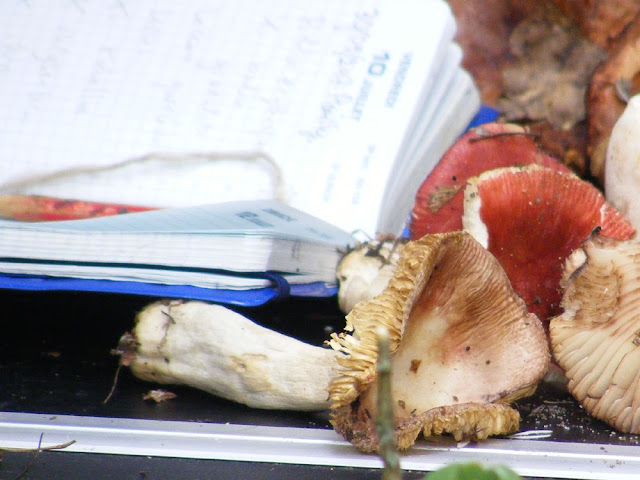Late September saw the recommencement of fungi outings by the Association de botanique et de mycologie de Sainte Maure de Touraine in the local forests. It had been dry, so no one held out much hope for many species on the day. In the end we identified 53 different species, which is about half what we would get on a good fungi foray in any of the old forests around here.
The Etang de Ribaloche, with very low water levels.
Wood Cauliflower Fungus Sparassis crispa (Fr. Clavaire crépu).
This edible fungus can grow to several kilos in weight. It is associated with pine trees.
Ivy growing up an oak.
A Dor Beetle Geotrupes stercorosus syn Anoplotrupes stercorosus (Fr. Géotrupe des bois).
Around here, this is by far the most common species of Dor Beetle, so beware of using Michael Chinnery's Insects of Britain and Western Europe to identify any Dor Beetle you discover. If it is in the woods and there is no cow dung in sight, it will not be G. stercorarius, the species featured by Chinnery. The species in my photo is a woodland species and relatively small but otherwise looks much like other Dor Beetles. They are irridescent blue black and like all other Dors, are dung processors. These ones are not overly choosy, burying the dung of many different mammals as well as leaf mould and fungi. To be sure of the identity you need to look at the rear tibia and check how many keels it has (sharp ridges across the outer facet). There should be two.
Common Rustgill Mushroom Gymnopilus penetrans (Fr. Flammule pénétrante).
A very common fungus of pine forests, they can appear in large numbers together. Despite its piecrust appearance it is probably toxic.
Shaggy Parasol Chlorophyllum rhacodes syn Macrolepiota rhachodes (Fr. Lépiote déguenillée).
Most parasol mushrooms are toxic so if you are a fan of the edible species Common Parasol Macrolepiota procera you need to make sure you know how to recognise its snakeskin patterned stem so you can tell it apart from the Shaggies and others. Shaggy Parasols blush slightly red if they are cut or bruised. It's quite a common woodland species.
Another parasol species, Lepiota ventriosospora syn L. metulaeospora.
Scarletina Bolete Neoboletus luridiformis syn
Boletus erythropus (Fr. Bolet à pied rouge).
Boletus erythropus (Fr. Bolet à pied rouge).
This is an edible mushroom, despite the lurid colours. However, it is rarely eaten, as it is often confused with the much better known and toxic Satans Bolete Rubroboletus satanas. The Scarletina stem goes from bright yellow to deep indigo when wounded. The Satan is creamy and just goes a bit blue when wounded. This is a mushroom I have wanted to see for several years, so I was pleased we found one.
Wood Mushroom Agaricus silvicola (Fr. Agaric des bois).
This pretty slightly pearly pink mushroom has an obvious stem ring and a faint smell of aniseed. It is edible, but you need to be able to distinguish it from the pale deadly Amanita species such as the Death Cap A. phalloides and the Destroying Angel A. virosa, which also grow in the woods. (I had a couple of Destroying Angels in the orchard a few days later.)
Blue Roundhead Mushroom Stropharia caerula (Fr. Strophaire bleu).
An unusual little blue mushroom, localised in distribution and found in calcareous beech woods.
Christian and his newly adopted dog.
Christian is a recently retired vet. The young dog was found wandering on the road. Fruitless attempts were made to find her owner, but finally Christian decided to keep her. She has no manners at all at the moment, but I'm sure will grow into a loved companion.
Identifying the fungi found on the day.
Russula poubellus.
That's a French mycology joke. The English name would presumably be Rubbish Brittlegill.
Apples and edible mushrooms gathered in the forest.
While we were identifying the fungal haul a family emerged from the forest. There were three generations of them, from kids to grandparents, and they'd been foraging. They had Weeping Boletes, Red-capped Scaber Stalks, False Chanterelles, and Shaggy Inkcap mushrooms, and apples. Information and advice was exchanged. They were clearly enthusiastic and knowledgeable foragers, and knew what they had. Nevertheless, they were reminded to peel the Weeping Boletes because the milky discharge that gives them their name can cause stomach upsets. They were also reminded to use the Shaggy Inkcaps that evening because if they left them until the morning they would have auto-digested and just be a pool of ink.
They wished us 'bonne omelette' and we parted on good terms.
We went outside this morning at 7.00am to do some meteor spotting. Because it was overcast we saw nowt, but it was very breezy and 16.5°C. The average maximum October temperature in Preuilly last year was 17°C, and her were are, 90 minutes before sunrise, and the temperature is close to that already. That'd be Brian's fault (I don't know if he has a French name yet).
***********************************************
We went outside this morning at 7.00am to do some meteor spotting. Because it was overcast we saw nowt, but it was very breezy and 16.5°C. The average maximum October temperature in Preuilly last year was 17°C, and her were are, 90 minutes before sunrise, and the temperature is close to that already. That'd be Brian's fault (I don't know if he has a French name yet).















3 comments:
"we saw nowt" WOT WOT WOT Love it... If you want to come over and practice your accent you most welcome...
Did you find any puffballs?
Yes, quite a few of the common warty ones.
Post a Comment